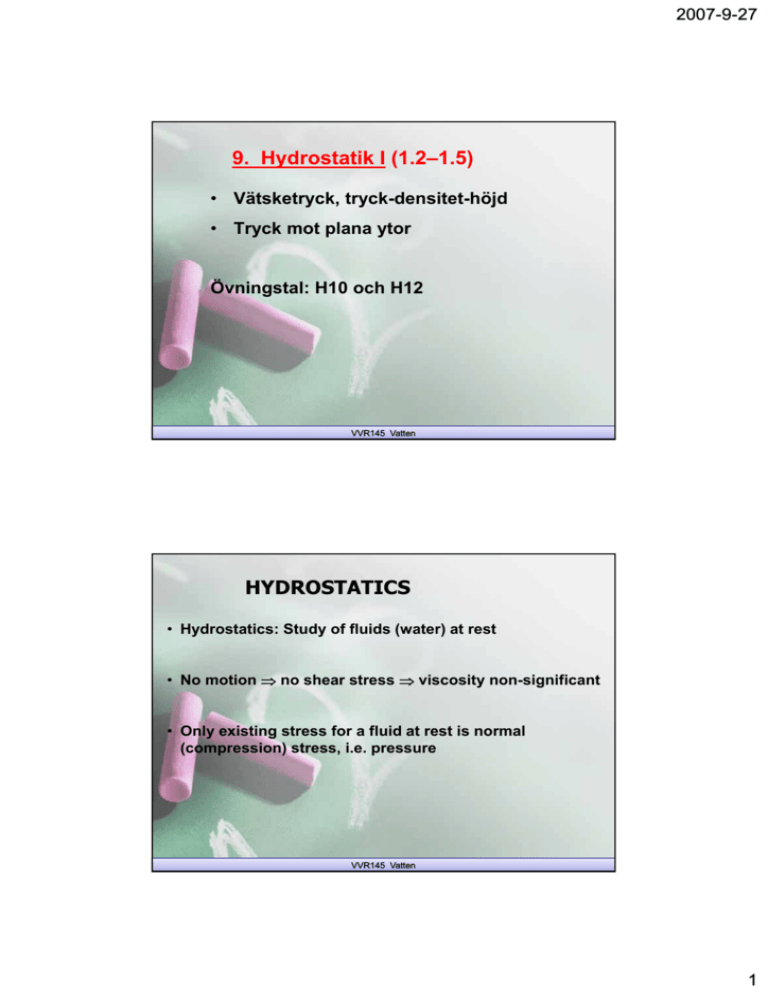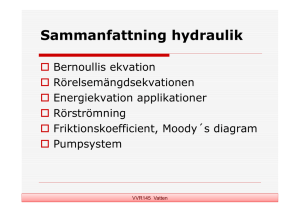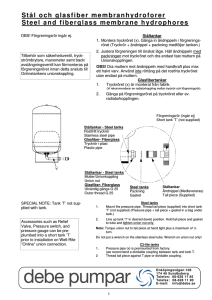9. Hydrostatik I (1.2–1.5) HYDROSTATICS
advertisement

2007--9-27 2007 9. Hydrostatik I (1.2–1.5) • Vätsketryck, tryck-densitet-höjd • Tryck mot plana ytor Övningstal: H10 och H12 VVR145 Vatten HYDROSTATICS • Hydrostatics: Study of fluids (water) at rest • No motion ⇒ no shear stress ⇒ viscosity non-significant • Only existing stress for a fluid at rest is normal (compression) stress, i.e. pressure VVR145 Vatten 1 2007--9-27 2007 Characteristics of pressure 1. Measurement unit [Pa]=[N/m2] 2. Pressure is transmitted normal to solid boundaries or arbitrary sections 3. Pressure is transmitted undiminished to all other points in a fluid at rest 4. Pressure has the same magnitude in all directions at a point in a fluid at rest (scalar quantity) VVR145 Vattenskalar => ingen vektor arbitrary = godtycklig Relation between pressure and depth in an incompressible liquid Assuming constant density and no horizontal pressure variation, the liquid column in the fig below can be used to determine the pressure as a function of depth. Vertical forces acting on column (V, A, and y are volume, area, and height of column, respectively): y A • Upward pressure force: P·A (EQ 1.2) • Weight (downward): wV = wAy • V ti l fforce balance: Vertical b l P·A = wAy ⇒ P = wy = ρgy • (EQ 1.8) Pressure often quoted as heads, h = P/w (in m H2O or mm Hg) heads = tryckhöjd VVR145 Vatten 2 2007--9-27 2007 ABSOLUTE AND RELATIVE PRESSURE • Pressures are measured and quoted in two different systems, one relative (gauge) and one absolute. ≈ 100 kPa • The relation between them is: Pabs = Patm + Pgauge (EQ 1.9) • Negative gauge pressures are often termed vacuum pressures • Often only relative pressures are of interest VVR145 Vatten gauge = tryckgivare EXAMPLE ON GAUGE AND ABSOLUTE PRESSURES A pressure gauge registers a vacuum of 310 mm of mercury when the atmospheric pressure is 100 kPa, absolute. Calculate the corresponding absolute pressure. Solution: Patmospheric t h i = 100 kPa (Pgauge/wHg) = -310 mm Hg ⇒ Pgauge = -0.31w Hg wHg = 133.0 kN/m2 (e.g., page 4; ρg) Pabsolute = Patmospheric + Pgauge ⇒ Pabsolute = 100 - 0.31⋅133.0 = 58.8 kPa VVR145 Vatten 3 2007--9-27 2007 Fig. 1.5 Typical examples of situations where hydrostatic force may have to be calculated VVR145 Vatten FORCE ON SUBMERGED PLANE SURFACES mini summary Example of applications: - Design of dams, ships, gates, and tanks. Characteristics of pressure in a fluid at rest: • Constant pressure on plane horizontal surface • Linear pressure variation with depth for constant density liquid • Pressure acts perpendicular to the surface VVR145 Vatten 4 2007--9-27 2007 • Pressure prism: “volume volume of pressure” pressure on the plane surface F = P A = ρgh A (EQ 1.11) • Resultant force is equal to the volume of the pressure prism and acts through its centroid γ = w (tunghet) prism = VVR145 prisma Vatten centroid = geometriskt centrum (‘yt-tyngdpunkt’) RELEVANT EQUATIONS – FORCES ON PLANE SUBMERGED SURFACES • Resultant force: F= whGA = ρghGA • LP = IG/(A LG) + LG A LP LG L Lp (EQ 1.11) Point of action of resultant force: (EQ 1.13) • A: area of plane surface; • h G: vertical distance liquid surface - area center; • LP: distance O - pressure center; t P=ρgh • L G: distance O – area center; • I G: second moment of area about area center axis; • L = h/sinθ Compare with Figure A1.1, page 554 ! IG = second moment of the area: yttröghetsmoment VVR145 Vatten Point of action = angreppspunkt 5 2007--9-27 2007 Page 10 VVR145 Vatten Median line gives lateral position for center of pressure for regular plane areas VVR145 Vatten 6 2007--9-27 2007 H10 A rectangular t g l gate g t 1.8 1 8 m long l g and d 1.2 12 m high lies in a vertical plane with its centre 2.1 m below a water surface. Calculate magnitude, direction and location of the total force on the gate. VVR145 Vatten H12 This rectangular gate will open automatically when the depth of water, d, becomes large enough. What is the minimum depth that will cause the gate to open? VVR145 Vatten 7 2007--9-27 2007 UPPGIFT 1 (6 poäng) Vilken kraft P behövs för att hålla kvar den 5 m breda (in i pappret) rektangulära luckan i sin position enligt figuren nedan? Luckans längd är L = 4 m och vattendjupet till vänster om luckan (till vänster om leden) är 2 m. Antag att leden är f ikti friktionsfri f i och h att tt vii har h luft l ft på å höger hö sida id om luckan. l k Försumma luckans egentyngd. VVR145 Vatten LÖSNING – steg 1: Rita ut relevanta krafter som verkar på luckan. VVR145 Vatten 8 2007--9-27 2007 10. Hydrostatik II (1.6–1.7) • Tryck mot buktiga ytor • Flytkraft / Archimedes princip • Övningstal: H15 och H18 VVR145 Vatten Fig. 1.27 Pressure on a sphere VVR145 Vatten 1 2007--9-27 2007 FORCES ON CURVED SUBMERGED SURFACES (1) Resolve the force into two components, one vertical and one horizontal Pressure intensity on a curved surface. F passes through the center of curvature. VVR145 Vatten (2) curvature = krökning The horizontal force is obtained by projecting the curved surface onto a vertical plane. The horizontal force is equal to the force on this projected area: FH = ρg hG,proj Aproj G P Projection of the curved surface onto a vertical plane VVR145 Vatten 2 2007--9-27 2007 (3) The vertical force is equal to the weight of the volume of liquid above the curved surface FV = = ρ· ρ·g g·V Kom ihåg: V = volym ovanför The vertical force component, FV, caused by the weight of liquid above the surface VVR145 Vatten (4) The resultant force is given by: F = F2 + F2 V H and the direction of the resultant force by: tan φ = Eq. 1.15 F V F H Eq. 1.16 The direction of the resultant force, F, which must also pass through C ((5)) Remember that there is an equal and opposite force acting on the other side of the surface. VVR145 Vatten 3 2007--9-27 2007 ARCHIMEDES PRINCIPLE – BUOYANCY FORCE Law of buoyancy (Archimedes’ principle): • “Th “The upthrust th t (buoyancy (b force) f ) on a body b d immersed in a fluid is equal to the weight of the fluid displaced” Law of flotation: • “A floating body displaces its own weight of the liquid in which it floats” VVR145 Vatten Proof of Archimedes principle Vertical forces acting cylinder surface: “Downwards” P1: p1A = ρ·g·yA = w ·yA “Upwards” P2: FB • p2A = ρ·g·(y+L)A= w·(y+L)A “Net pressure force (upthrust)”, FB: FB = w(y+L)A - wyA= wLA = = wV = ρ·g·V Eq. 1.14 VVR145 Vatten 4 2007--9-27 2007 H15: The quarter cylinder AB is 3 m long. Calculate magnitude, direction, and location of the resultant force of the water on AB. Z X C VVR145 Vatten H18: The weightless sphere of diameter d is in equilibrium in the position shown. Calculate d as a function of w1, h1, w2, and h2. w1 w2 Sfärs volym = πd3/6 Area = πd2/4 VVR145 Vatten equilibrium = jämvikt 5 2007--9-27 2007 11. Hydrostatik III (1.8, 1.9, 2.1-2.7) • Hydrostatiska jämviktsekvationen • Tryckmätning, manometri • Övningstal: H1, H3-4 och H8 VVR145 Vatten Hydrostatiska Jämviktsekvationen (samband mellan tryck, densitet och vertikalt avstånd) The general relation for pressure in a static fluid is: dp dz = −γw = − ρ g => z dp = - w · dz Implication: pressure varies only with depth and is constant in a horizontal plane VVR145 Vatten OBS: z pekar uppåt 1 2007--9-27 2007 For a fluid with constant density: p1 – p2 = γ (z2 – z1) = γ · h or h= • (p2, z2) p −p 1 2 h γ • (p1, z1) z Implications: • pressure varies linearly with depth • pressure may be expressed as head of fluid of weight density w • pressure are often quoted as head in mm Hg or m H2O • p 1 p 2 +z = + z = Const , for all points in a fluid at rest 1 2 γ γ VVR145 Vatten H1: The weight density (w = ρ⋅g) of water in the ocean may be b calculated l l t d from f the th empirical ii l 1/2 relation w = w0+ K⋅(h) , in which h = the depth (m) below the ocean surface. Derive an expression for the pressure at any point h and calculate weight density and pressure at a depth of 3220 m assuming w0 = 10 kN/m3, K = 7.08 N/m7/2. VVR145 Vatten 2 2007--9-27 2007 Sample problem: An open tank contains water 1.4 m deep covered d by b a 2 m thick thi k layer l off oil il (r.d.=0.855). ( d 0 855) What is the pressure head at the bottom of the tank, in term of a water column? VVR145 Vatten (r.d. = relative density) Mini summary: VVR145 Vatten 3 2007--9-27 2007 MEASUREMENT OF PRESSURE VVR145 Vatten MANOMETRY Pressure is constant over horizontal planes within continuous columns of the same fluid Conversion of manometer readings to Pressure (γ = w) (a) p1 = p2 (b) p4 = p5 p1 = px + γ l p4 = px + γ1l1 p2 = patm + γ1h ⇒ px = patm + γ1h - γ l p5 = py + γ2l2 + γ3h (absolute) ⇒ px - py = γ2l2 + γ3h - γ1l1 VVR145 Vatten 4 2007--9-27 2007 H3: With the manometer reading as shown, calculate px. L R VVR145 Vatten (r.d. = relative density) H4: Calculate px - py for this inverted U-tube manometer. ρ = r.d. ⋅ ρwater). L R VVR145 Vatten (r.d. = relative density) 5 2007--9-27 2007 H8* The sketch shows a sectional view through a submarine. Calculate the depth of submergence, y. Assume that the weight density of sea water is 10.0 kN/m3. R L VVR145 Vatten 6


